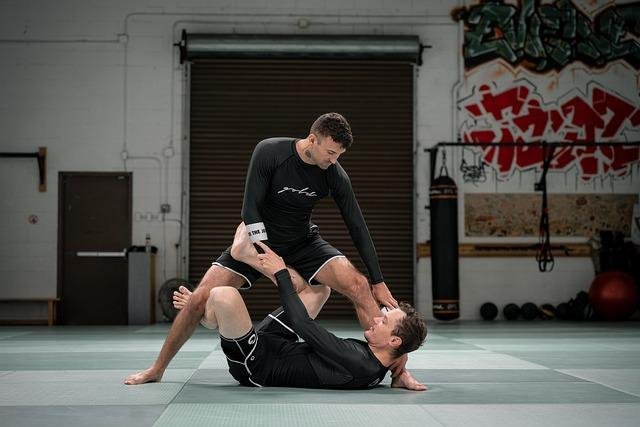As the mixed martial arts (MMA) landscape gears up for a new era, a wave of Jiu-Jitsu fighters is spearheading what experts are calling the “2025 MMA Transition Surge.” These athletes, renowned for their grappling mastery and strategic combat skills, are making notable inroads beyond traditional Jiu-Jitsu circuits, increasingly shaping the future dynamics and competitive standards of MMA. This article explores how their unique approach is redefining the sport and setting the stage for a transformative period in MMA history.
Table of Contents:
- Jiu-Jitsu Specialists Redefining Striking and grappling Dynamics in MMA
- Analyzing the Tactical Edge Jiu-Jitsu Brings to Modern Mixed Martial Arts
- Training innovations Propelling Jiu-Jitsu Fighters to the Forefront of MMA Competition
- Expert Recommendations for Aspiring Fighters Embracing Jiu-Jitsu Techniques in MMA
- Insights and Conclusions
jiu-Jitsu Specialists Redefining Striking and Grappling Dynamics in MMA
In an unprecedented shift within the MMA landscape,Jiu-Jitsu specialists are no longer confined to ground dominance but are actively transforming the striking realm. Fighters with a strong grappling foundation are integrating dynamic striking techniques, resulting in a hybrid style that challenges traditional combat paradigms. Their approach emphasizes fluid transitions between stand-up exchanges and ground control, making them unpredictable opponents. This evolutionary trend not only carves new tactical frameworks but also elevates the strategic complexity of matches in the coming season.
Key innovations spearheading this change include:
- Advanced clinch work blending striking with immediate submission setups
- Increased use of feints and baiting maneuvers to lure opponents into grappling range
- Conditioning regimes focused on endurance for sustained striking-grappling exchanges
- Adaptive defense techniques that seamlessly switch between strikes and takedown counters
As these fighters redefine the boundaries between striking and grappling, they are setting a new standard that competitors across divisions are beginning to emulate. The ripple affect is evident, with coaches and training camps revising curricula to incorporate this dual-threat methodology.This evolution signals a vibrant future where the art of Jiu-Jitsu is inseparably intertwined with striking innovations, marking a defining chapter in MMA history.
Analyzing the Tactical Edge Jiu-Jitsu Brings to Modern Mixed Martial Arts
As the landscape of mixed martial arts (MMA) evolves, Jiu-Jitsu practitioners are redefining the strategic blueprint of the sport. Their mastery of ground control and submission techniques offers a tactical versatility that often neutralizes the striking supremacy of opponents. Unlike traditional combat styles that emphasize stand-up fighting, Jiu-Jitsu’s core strengths lie in its ability to dictate the pace and positioning of a fight once it hits the mat.this distinct edge enables fighters to transition seamlessly between offensive and defensive maneuvers, turning grappling exchanges into opportunities for decisive finishes.
Beyond technique, the mental agility and adaptability ingrained in Jiu-Jitsu training foster a competitive mindset crucial in MMA’s dynamic environment. Fighters excel in:
- Reading opponent movements to anticipate and counter attacks effectively
- Conserving energy through efficient movement and control strategies
- Maintaining composure under pressure,leveraging patience to capitalize on opponents’ mistakes
These qualities contribute to a thorough tactical edge,making Jiu-Jitsu not just a fighting style but an integral component of modern MMA success strategies heading into 2025.
Training Innovations Propelling Jiu-Jitsu Fighters to the Forefront of MMA Competition
Groundbreaking training regimens are transforming the way Jiu-jitsu fighters sharpen their skills for MMA,blending traditional technique with cutting-edge methodologies. Fighters are increasingly integrating high-intensity interval training (HIIT) and advanced analytics to optimize their endurance and grappling precision. Gyms equipped with smart mats and motion capture technology allow coaches to dissect every movement,providing real-time feedback that accelerates skill acquisition far beyond classic drilling routines. This data-driven approach is not only elevating performance but also drastically reducing injury risk during competition prep.
Innovative cross-discipline sparring sessions have become pivotal, enabling Jiu-Jitsu specialists to develop seamless transitions between striking and ground game under fight conditions.key elements shaping this evolution include:
- Virtual Reality Combat Simulations to replicate diverse fight scenarios
- Biomechanical Assessments for tailored strength and flexibility programs
- Mindfulness and Cognitive Training techniques to enhance focus and tactical decision-making
These advances are propelling Jiu-Jitsu practitioners to a competitive advantage,positioning them as frontrunners in the rapidly shifting 2025 MMA landscape.
Expert recommendations for Aspiring Fighters Embracing Jiu-Jitsu Techniques in MMA
As the MMA landscape evolves rapidly, elite coaches emphasize the integration of Brazilian Jiu-Jitsu fundamentals with striking and wrestling disciplines. Top trainers recommend aspiring fighters focus on developing a versatile grappling arsenal, blending submission proficiency with seamless positional transitions to capitalize on ground control during high-stakes bouts. This holistic approach demands rigorous drilling of techniques like guard retention, sweeps, and back control escapes while enhancing the ability to adapt under pressure. Experts also highlight the value of cross-training within various Jiu-Jitsu styles, including no-gi and sport-specific variations, to build a dynamic combat skill set adaptable to any opponent’s strategy.
Key strategies advised for newcomers include:
- Prioritizing cardio conditioning to maintain stamina during extended ground exchanges.
- Regular sparring sessions with diverse fighters to simulate real fight scenarios and sharpen reaction time.
- Studying fight film of top Jiu-Jitsu practitioners to analyze tactics and identify common transitional patterns.
- Mental resilience training to stay composed during adversity on the mat.
These expert-endorsed practices are proving instrumental in cultivating the next generation of MMA competitors who are as formidable with submissions as they are with striking, fueling the ongoing surge of Jiu-Jitsu specialists poised to dominate the 2025 MMA scene.
Insights and Conclusions
as the landscape of mixed martial arts continues to evolve, Jiu-Jitsu fighters are clearly at the forefront of the sport’s next significant transition. Their blend of technical mastery and strategic adaptability is setting new standards and inspiring a fresh wave of competitors entering the MMA arena. With 2025 poised to be a pivotal year,the influence of these grappling specialists is expected to shape the future of MMA in profound ways,heralding a new era defined by innovation,resilience,and the enduring art of Jiu-Jitsu.

